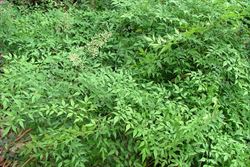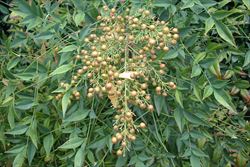Click on images to enlarge

habit (Photo: Sheldon Navie)

leaves (Photo: Sheldon Navie)

clusters of flower buds (Photo: Sheldon Navie)

close-up of flowers (Photo: Sheldon Navie)

immature fruit (Photo: Sheldon Navie)

mature fruit (Photo: Sheldon Navie)

close-up of seeds (Photo: Steve Hurst at USDA PLANTS Database)

dwarf sacred bamboo, Nandina domestica 'Nana' (Photo: Sheldon Navie)
Scientific Name
Nandina domestica Thunb.
Family
Beberidaceae
Common Names
heavenly bamboo, Japanese sacred bamboo, nandina, sacred bamboo, sacred Japanese bamboo, southern heaven bamboo
Origin
Native to eastern Asia (i.e. China and Japan).
Naturalised Distribution
Occasionally naturalised in some parts of central and northern New South Wales and sparingly naturalised in south-eastern Queensland.
Also naturalised in large parts of south-eastern USA (i.e. Texas, Louisiana, Mississippi, Alabama, Florida, Georgia, South Carolina, North Carolina and Virginia).
Notes
Sacred bamboo (Nandina domestica) is regarded as an environmental weed in New South Wales and as a potential environmental weed or "sleeper weed" in other parts of Australia (i.e. Victoria and Queensland).
This species is currently of most concern in the wider Sydney and Blue Mountains region in central New South Wales. It is currently not very widespread or common, but its abundance and range is increasing. Sacred bamboo (Nandina domestica) is listed as an environmental weed by the Blue Mountains City Council, and it is occasionally found in bushland edges and along drainage lines in this region. It has also been recorded in conservation areas in the Blue Mountains (i.e. Tunnel Gully Reserve) and in suburban Sydney (i.e. The Lakes of Cherrybrook in Hornsby Shire).
Sacred bamboo (Nandina domestica) is seen as a potentially serious environmental weed in Australia because of its history as a weed in the USA. This species has invaded floodplains, woodlands and forests in northern Florida and adjacent areas in Georgia and Alabama. It has been recorded in numerous conservation areas in Florida, where it is relatively common. For example, it has formed dense populations and is displacing native vegetation in the Florida Caverns State Park, including local rare and endangered species (i.e. the red columbine, Aquilegia canadensis, and the oak-leaf hydrangea, Hydrangea quercifolia).
Sacred bamboo (Nandina domestica) is mainly a problem in warmer temperate and sub-tropical regions in the USA, and may therefore have potential as a weed throughout the wetter parts of eastern New South Wales and south-eastern Queensland.
Note: Numerous cultivars are available and are now more commonly seen in cultivation that the original form of this species. Some of the modern cultivars do not produce fruit, or produce fewer fruit, and are therefore not as invasive (e.g. 'Nana', 'Harbour Dwarf' and 'Firepower'). The most common of these in cultivation in Australia is known as dwarf sacred bamboo (Nandina domestica 'Nana').

